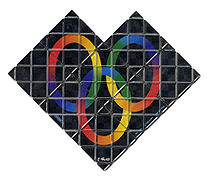Rubik's Magic
Rubik's Magic is a mechanical puzzle game that, like the Rubik's Cube, was invented by the Hungarian Ernő Rubik . The game enjoyed great popularity in the mid-1980s as a result of the Rubik's Cube boom. It is often viewed as its successor, although as a puzzle it differs significantly from Rubik's Cube.
Description and goal
Rubik's Magic is a three-dimensional puzzle game for one player. It consists of eight square plastic plates that are connected to one another with nylon cords in the manner of Jacob's ladder . Ring patterns are printed on both sides of the plates, the cords lie in the diagonal grooves. The connections of the segments change by flipping over movements, which is why the Rubik's Magic can take on many different forms. The apparent aim of the game is to transform the pattern of three adjacent rings, seen in the basic rectangular position on the front, into one with three intertwined rings on the back, in which the plates form a hexagonal heart shape . The first editions from 1986 onwards have a black background and rainbow colored rings. Editions from the mid-1990s on have gold rings on a red background.
construction
The diagonal lacing in the manner of a Jacob's ladder does not allow the segments to be rearranged. Each plate is inextricably linked to exactly two neighbors, and their orientation to one another does not change either. That means: if you fold two neighbors together, the same edges are always on top of each other. If you carry out the folding movement slowly, you will notice how the tension of the nylon threads changes and you can open it again in a right-angled direction. The squares are then along another edge connected , the movement they can rotate around each other.
Different shapes and arrangements
In addition to the basic forms of plaque and heart the Rubik's Magic can take over 60 more, mostly three-dimensional shapes that are characterized by more or less symmetry or associations to other objects arouse such star , fish , desk , cubicle or dice . This variety of shapes makes up the real attraction to play and enables creative use of the puzzle. The edges of the panels are shaped in such a way that they are preferably arranged at 90 ° or 180 ° angles and, so to speak, snap into such positions. In the enclosed game instructions and supplementary books, various forms are shown schematically that the player can reproduce. Thus, an exact number of all possible shapes cannot be given, but for example all flat possibilities are known.
Nevertheless, the order of magnitude of the actually different shapes that the Rubik's Magic can assume, as well as the number of different plate arrangements that exist for a certain shape, is a few powers of ten less than, for example, the number of possible positions of the Rubik's Cube. In addition, the pattern with the three free rings in the basic position has nothing to do with the intertwined one in the heart shape: One is on the front, the other on the back of the segments, and the segments can not change their parity with one another - the front - and the back cannot be mixed together.
Chalkboard , chain and heart
If you fold the two-dimensional 4x2 arrangement, also known as the board , along the long central edge , the Rubik's Magic can be opened into a three-dimensional ring-shaped arrangement, the so-called chain . Each plate is connected to its two neighbors on opposite edges. If you look at a square, a neighbor can lie on one of the four edges, its orientation is fixed and with it the whole chain . In addition, each chain can be distinguished from the inside and outside, so there are different chains . Each chain can be opened into a board in four different ways , so there are different boards. The ring pattern is only correct on one side of one of them, that is the basic position . In order to get from the board to the heart by the shortest route , a sequence of six folding movements is necessary, which can be performed in two different ways on each board. This results in different arrangements for the heart shape ; one of them is the objective .
variants
- In addition to the standard version with eight surfaces, there are extensions with twelve (Rubik's Master Magic) and 16 surfaces.
- At the same time, a strategic two-person game appeared under this name, in which the players have to turn over a row of 16 tiles by alternating placing, similar to the game Gobang .
literature
- Christoph Bandelow : Rubik's magic rings . Falken-Verlag , Niedernhausen 1986, ISBN 3-8068-0878-3 .
Web links
Individual evidence




